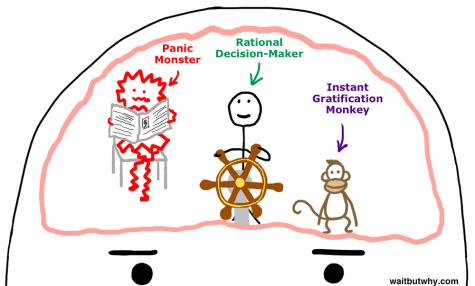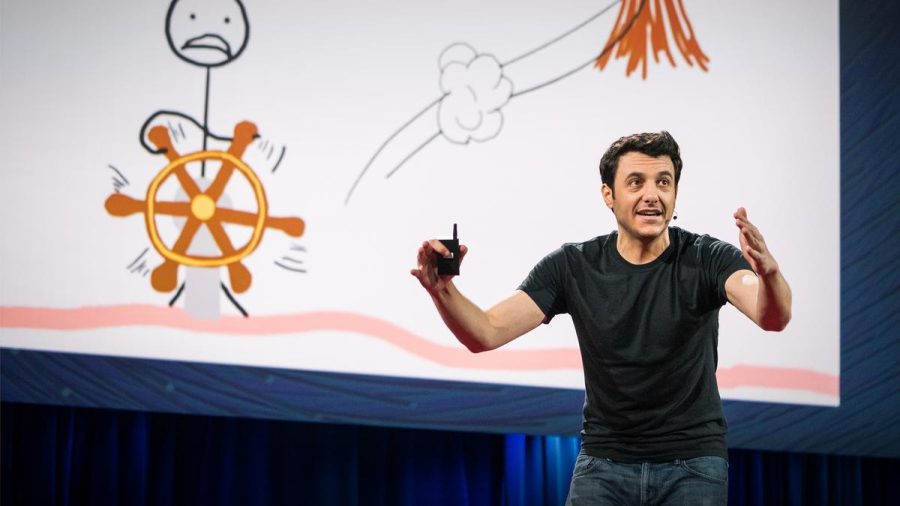Procrastination is normal. Thanks, Tim Urban.
March 7, 2022
Endlessly scrolling through Instagram, binging random videos on Youtube, watching Netflix. Alternatively, doing homework, or studying for APs. Before listening to Tim Urban’s TEDTalk, “Inside the mind of a master procrastinator”, I probably would’ve felt guilty choosing the first option instead of completing my work, but Urban helped me realize how human procrastinating is. Somehow, Tim Urban perfectly put into words what procrastination is. When Urban says “…from all different kinds of people from all over the world, doing all different kinds of things…” It made me realize that I’m just like everyone else, and it’s okay to procrastinate because, from every walk of life, there are procrastinators. I think it’s important for high schoolers especially to hear this speech because every high schooler at some point procrastinated their work, but then they felt guilt. Why should we feel unnecessary guilt, when we’re just being human? Today, I will be analyzing Tim Urban’s 2016 TEDTalk on procrastination. Here are two other TEDTalks that I highly recommend.
First, I will be analyzing the speech’s objectives, audience, and context. Urban’s goal was to inform, entertain, and empathize. He informed the audience how non-procrastinators and procrastinators’ minds are different in that procrastinators have what Tim Urban calls an “instant-gratification monkey”. This monkey prefers to experience pleasure right now, in the present moment. This monkey “takes the wheel” of the brain and disregards the “rational-decision maker” part of the brain. This causes procrastination because instead of doing what someone is supposed to be doing, they do something just to receive pleasure at that moment. One of Tim Urban’s methods of procrastination was “watching interviews of Justin Bieber’s mom.” Then, everything is fine until the “panic monster” sets in, due to deadlines or other pressures. The panic monster scares away the “instant-gratification monkey” and causes the “rational-decision maker” to take the wheel again and get work done. His clever use of diagrams and drawings helped piece this message together in a chronological sequence of 3 phases of procrastination. Another argument Urban holds is that everyone is a procrastinator at some point in time. There are no total non-procrastinators, just people who are more comfortable with deadlines and make better use of their time. Because he calls everyone procrastinators, saying “I don’t think non-procrastinators exist”, the audience context is not as relevant since he is saying that everyone can relate to what he is saying. This also establishes why the audience should listen because every audience member can benefit from his entertaining, yet insightful speech. Urban is the best candidate to be giving this speech because he certainly earns the nickname “master procrastinator”. In the first minute, he shares an anecdote about how in college, he crammed his year-long project of writing his 90-page senior thesis into 3 days, even having to pull 2 all-nighters. Even though none of us can relate to Urban in this specific example, we all have our times in which we procrastinate.
Next, I will be analyzing the opening, body, and conclusion of Urban’s TEDtalk. Urban’s opening words were telling the anecdote of his 90-pg thesis fiasco. He also uses two diagrams to explain how a “normal student writes a paper” versus how Urban would write papers. This attracts and engages the audience because firstly, it establishes the difference between a non-procrastinator versus a procrastinator, AKA Tim Urban. Secondly, it’s entertaining because we expect diagrams to be usually scientific, but he uses diagrams as a means of entertainment, while still providing information and good context for his speech. Moving onto the speech’s body. Here, he discussed the 3 phases of procrastination and other points, such as how there are no non-procrastinators and also another form of procrastination, that is very dangerous – procrastination when there are no deadlines. Urban explained the three phases of a procrastinator’s mind in chronological order. To recap what I mentioned before, first is the instant gratification monkey taking over, then the panic monster settling in, and finally, the rational-decision maker takes control once again. Seamless transitions were used throughout this, such as when he was introducing the panic monster, he said “Well, turns out the procrastinator has a guardian angel…someone called the Panic Monster.” This segways into the second phase of a procrastinator. But what happens when there are no deadlines, meaning the panic monster doesn’t have that pressure to set in? Important events with no deadlines could be exercising, building relationships with friends and family, etc. This causes procrastination to extend forever. When discussing this, Urban takes on a more serious tone than his usual banterful tone. He uses powerful diction when saying “It’s usually suffered quietly and privately. And it can be the source of a huge amount of long-term unhappiness, and regrets…long-term procrastination has made them feel like a spectator…in their own lives. The frustration is not that they couldn’t achieve their dreams; it’s that they weren’t even able to start chasing them.” This should act as a wake-up call to all. To support his points, he used many rhetorical devices and also visual aids. The rhetorical devices he used were very successful in helping him get his point across. I mentioned multiple devices already – anecdotes, diction, and he also uses metaphors and personification. His anecdotes entertain but also allow us to empathize with him, and his sharing shows he can empathize with fellow procrastinators in the audience. Metaphors were when he compares instant gratification to a monkey, panic to a monster, and a wheel as to how the brain makes decisions. He personified all of these, giving them real traits (For example, instant-gratification monkey climbing up a tree when scared). The visual aids Urban used were his diagrams and drawings. They were effective because they easily visualize what he is trying to say in easy, understandable terms. Instant-gratification is depicted as a monkey, taking over the wheel. Then, a panic monster sets in and scares the instant-gratification monkey up into a tree, allowing the rational-decision maker to set back in.

Last (but certainly not least!) is the conclusion, which he segues into by saying “Now, I want to show you one last thing…” to signify the speech is coming to a close. The conclusion acts as a call to action and is built off of the last point of long-term procrastination. Urban shows the audience an image filled with boxes, saying that each box represents one week, assuming a 90-year life. Urban encourages and persuades the audience into understanding that procrastination is causing us to waste our lives away, wasting each little box until there are no boxes left. This provides psychological closure by somewhat scaring people, essentially saying we don’t have enough time to be procrastinating. He is saying that everyone should be aware of time and act today (with humor, of course, saying, “…it’s a job that should probably start today. Well, maybe not today, but … You know. Sometime soon.”) I highly recommend at least taking a minute and 30 seconds out of your life just to hear the conclusion.

Tim Urban is such a unique speaker, and I would love to hear more from him. I will now be analyzing his delivery skill, language, and appeal to ethos/logos/pathos. One of the reasons why I would want to hear more from him is because his enthusiasm and connection to the audience were unreal. Urban was clearly having fun up on stage. He seems very relaxed and very natural up on stage. He had an at-ease demeanor. A big giveaway he was at ease was his humor, use of stage area, gestures, and eye contact. His biggest strength was his humor, as it was very effective and made him seem very personable. Not only did it show Urban was at ease, as he was able to crack jokes, it also puts the audience at ease. This causes the audience to like Urban, therefore causing the audience to want to hear more of him so they can get some more laughs. Urban allowed for good pacing, especially after his jokes. He gave the audience time to laugh, and his ratio of humorous lines to information worked well. His speech was very easy to understand due to his pacing being in a good target words-per-minute said (for me, at least). I think for some people’s standards, he may have been talking a little too fast, but the standards I mean are in more of a formal setting. Urban’s pacing, vocal variety, and modulations in pitch make it seem very conversational, and it adds tons of emotion to his speech, and also seems more human, not robotic, which made me like him more. It’s not like the usual TEDtalk, which consists of a scientist talking for what seems like hours about some plant they found. In terms of language, unlike a scientist, he uses everyday language because procrastination is an every human problem. His use of everyday words adds another level of humanity to his speech. Urban’s use of stage area was just him walking all around the stage, indicating he is at ease. He also scanned all around the audience, almost as if he was having a conversation with these people. Urban’s hand movements/gestures added to the humor. Most notably, when he spoke for his rational-decision maker, he said “Are we clear on what we just accepted?” The primary use of ethos was establishing himself as a true “master procrastinator” with the 90-pg thesis story, admitting to procrastinating this TEDtalk, and also saying he’s a writer/blogger for Wait But Why, in which he writes about many topics, including procrastination. Urban’s use of the rhetorical device of anecdotes appealed to pathos, as every procrastinator understands what he was going through, even if they aren’t the exact situations he is in. The visual aids appealed to logos as they easily conceptualized the information and followed a logical chronological order when explaining the 3 stages of procrastination.
Even if it’s human to procrastinate, just remember those boxes of your life. Think about all those boxes we have left in our lives – do we really want to waste them by a constant cycle of procrastination and cramming?











